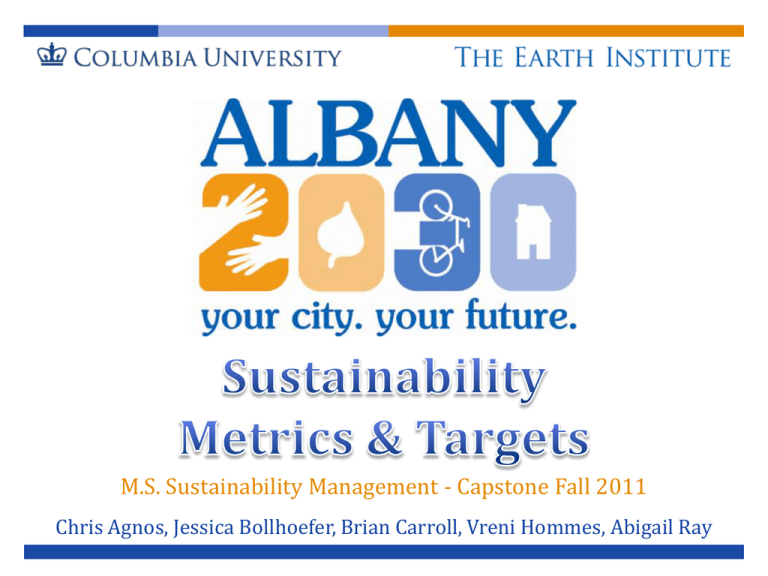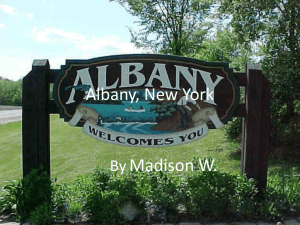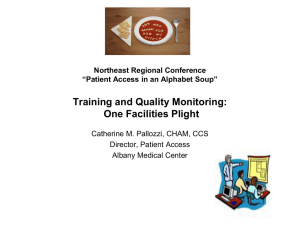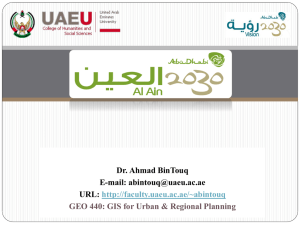Final Briefing
advertisement

M.S. Sustainability Management - Capstone Fall 2011 Chris Agnos, Jessica Bollhoefer, Brian Carroll, Vreni Hommes, Abigail Ray Agenda Overview of Albany 2030 Plan Plan Structure Research Methodology & Analytic Framework Challenges Research Findings and Recommendations Analysis Next Steps Agenda Structure Methodology Challenges Recommendations Analysis Next Steps 2 Plan Structure Community Form Comprehensive Plan Systems (8) Economy Social Goals (39) Transportation Natural Resources Strategies (~150) Housing & Neighborhoods Utilities & Infrastructure Actions (~500) Agenda Structure Methodology Institutions Challenges Recommendations Analysis Next Steps 3 Analytic Framework True sustainability requires: Holistic thinking Interconnectedness “Triple bottom line” metrics Agenda Structure Methodology Environmental Economic Challenges Recommendations Social Analysis Next Steps 4 Research Methodology Goal Prioritization Agenda Structure Research: Case Studies Benchmarks Methodology Challenges Define Metrics Recommendations Propose Targets Analysis Next Steps 5 Challenges Developing criteria for Integrating environmental, social and economic components to create the goals metrics Finding cities with sustainability plans that measure success Setting appropriate for Albany given their capacity and available resources Agenda Structure Methodology Challenges Recommendations Analysis Next Steps 6 Recommendations For each of the 23 high priority goals, we researched and recommended the following items: Agenda Metric and metric category Alternate metrics Metric Rationale Target Benchmarks / Case studies Data needed Structure Methodology Challenges Recommendations Analysis Next Steps 7 Stormwater Goal Description: Use stormwater management best practices to reduce impacts on water quality and mitigate costs of engineered stormwater systems Metric Category: Eco-Efficiency Metric: Amount of stormwater diverted into green infrastructures Environment Economic Social Target: Capture the first inch of rainfall on 10% of the impervious areas in combined sewer watersheds through detention or infiltration source controls by 2030 Agenda Structure Methodology Challenges Recommendations Analysis Next Steps 8 Stormwater Alternative Metrics: Eco-Efficiency: Cost savings from reducing the number of annual CSOs Eco-Efficiency: Stormwater management costs mitigated per unit of water absorbed by impervious surfaces "Protecting Water Quality from Urban Runoff." Document No. EPA 841-F-03-003 Agenda Structure Methodology Challenges Recommendations Analysis Next Steps 9 Stormwater Benchmarks / Case Studies: New York, NY: Capture the first inch of rainfall on 10% of the impervious areas in combined sewer watersheds through detention or infiltration source controls by 2030 Philadelphia, PA: “Green infrastructure” ordinances require developers to manage the first inch of stormwater on-site Agenda Structure Methodology Challenges Recommendations Analysis Next Steps 10 Recommendations Summary Goal Metric Target Land Use Pattern Percent of vacant lots occupied/restored Number of Historic Resources Commission “approved” projects that are repurposed vacant Architectural Character lots, brownfields, or ‘Registered Historic Structures.” Employment Percentage of households that earn a living wage Investment Percentage of employment/income coming from small businesses Diversity Percent of employment/payroll represented by small business by NAICS codes Number of incidents per police precinct. For prevention, the metric will be to track the Public Safety number of people served by outreach efforts in each neighborhood. Unemployment: # number of training programs for prisoners re-entering the workforce Social Services Health care: # number of free and readily available health care for women and children Hunger: # number of food pantries and percentage of stock available. Multi-Modal Decrease vehicles miles travelled (VMT) by single occupancy vehicle (SOV) commuters in Connections Albany. Bicycling Dollar spent per mile of bike lane per neighborhood Employment Goal Increase employment opportunities at all education/skill levels, and raise local incomes Transportation Agenda Increase the allocation of infrastructure funding per mile of bike lane per neighborhood. 100% of Albany households are within a half mile of at least one mode of public transportation Reduce levels of all contaminants to improve surface water quality Increase tree canopy coverage by 5-15% per neighborhood by 2030. Create a baseline and database of native flora and fauna and set target increase. Reduce AQI levels. Maintain 100% “good”-rated days on the EPA’s Air Quality Index. Increase percent of affordable housing by 20-30%. Decrease the number of vacant lots or brownfields by 10-20% per neighborhood. Track the percentage of households that have their basic services met within a 1/4 mile of basic minimum services as a baseline and increase figures by 20-40% annually. Reduce Albany municipal building energy from fossil fuels 20% and obtain 25% of renewable energy Biochemical oxygen demand (BOD5) of 20 milligrams per liter (mg/L) or less. Capture the first inch of rainfall on 10% of the impervious areas in combined sewer Amount of stormwater diverted into green infrastructures. watersheds through detention or infiltration source controls by 2030. Increase the amount of waste diverted from the landfill from 42% to 65% by 2030 Increase the amount of waste diverted from landfills. (already set by Albany), and expand organic waste diversion to 10%. Number of households, by neighborhood, with access to broadband internet service with a 60% of all Albany households have and use broadband connections with 20 Mpbs or minimum speed of 4 megabits per second (Mbps) more by 2030. Amount of PILOT money collected as percentage of total budget 5% of revenue collected as PILOT Maintain and improve the air quality in the city of Stormwater Solid Waste Albany Fiscal Impacts 95% of Albany’s households earn a livable wage by 2030. 50% of employment and payroll is attributed to small business by 2030 Targets should be double the current proportion to an ultimate target of 50% by 2030. Decrease crime by 20-40% through raising awareness of crime prevention measures offered through community outreach programs. Percentage of households that 95% of Albany’s households Decrease commuter VMT by SOV by 5-10%. earn a living wage earn a livable wage by 2030 Number of households who are within ½ mile of at least 1 mode of public transportation Air Quality Goal Communications Identify baseline of vacant lots, brownfield sites and Registered Historic Structures baseline data on percentage of assistance among people who are in need of Employment MetricEstablish Employment Target social services, and work on the county level to improve it. Waterways Water quality standards (drinking and surface water) Urban Forest Percent of tree canopy coverage by neighborhood Natural Habitat Number of native flora & fauna species present in the Albany Pine Bush Preserve Air Quality Number of days air pollutants achieve a “good” rating on the Air Quality Index (AQI) Housing & Diversity Percent of affordable housing per neighborhood and percent of existing affordable stock Choice preserved. Neighborhood Diversity Percentage of vacant lots or brownfields per neighborhood Number of households that are within1/4 mile of basic minimum services based on survey Neighborhood Services results. Amount of electricity used by energy source (e.g. coal, natural gas, alternative energy) and Energy sector. Water & Sewer Biochemical oxygen demand (BOD) levels (number of days in violation). Management Reduce percentage of vacant and unoccupied lots by 15-30% by 2030. Structure Air Quality Metric Air Quality Target Pollutant levels and number of days air pollutants achieve a “good” rating on the EPA’s Air Quality Index (AQI) Reduce pollutant levels by 20% and maintain 100% “good”rated days on the EPA’s Air Quality Index Methodology Challenges Recommendations Analysis Next Steps 11 Analysis Few cities have sustainability plans that are using a TBL approach or measuring success Cities with more Cities that use quantifiable metrics will likely be more successful at tracking and are more likely to have quantitative goals their sustainability goals will more effectively measure social, economic and environmental success Agenda Structure Methodology Challenges Recommendations Analysis Next Steps 12 Next Steps Present to Albany’s Planning Department Refine targets Present metrics and targets to stakeholders Integrate metrics and targets into the final Albany 2030 plan Agenda Structure Methodology Challenges Recommendations Analysis Next Steps 13 Questions?








